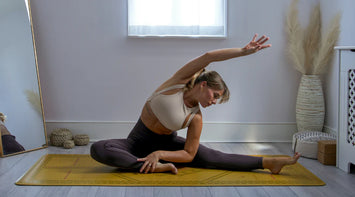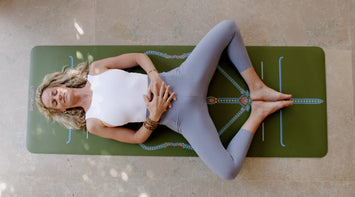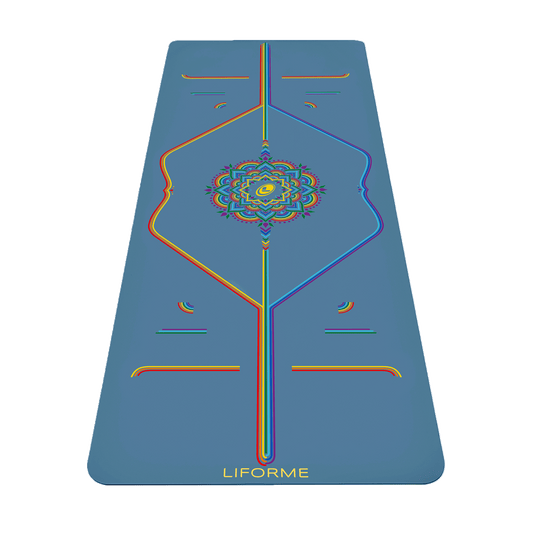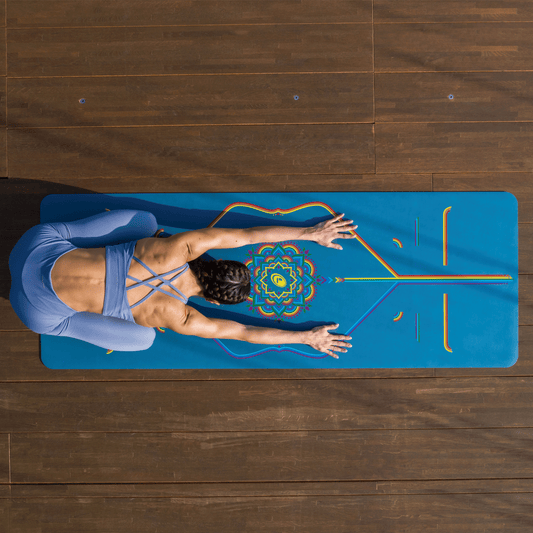Yoga’s seated poses include straight and cross-legged postures, forward folds, and twists. These types of postures are appropriate for practitioners of all levels with the use of props as necessary to promote safe alignment. You can do them to loosen up at the beginning of a yoga session but you will probably be able to go deeper if you revisit them toward the end of your practice after you’ve generated some heat with standing postures.
What are the Benefits of Seated Yoga Poses?
Seated poses are ideal for improving flexibility by stretching the legs (hamstrings, quads, and calves), back, and muscles around the pelvis, also known as the hips. Sitting on the floor on your yoga mat provides a position of stability, which facilitates opening the body, but it’s not comfortable for everyone. If you find it difficult to sit up straight, try taking a folded blanket, bolster, or block under your bum. Raising your hips often helps your spine come into a more sustainable alignment.
11 Seated Poses to Get You Started

Staff Pose (Dandasana)
Benefits: Improves postural awareness, opens the legs, chest, and shoulders.
Alignment Insights: You’ve probably heard it said that Mountain Pose is the alignment touchstone for many of yoga’s standing poses. Staff Pose is the equivalent for seated postures: an alignment baseline. Like Mountain, it looks deceptively simple but requires close attention to detail.
Step-by-Step Instructions:
- Come to sit with your legs extended straight out in front of you. If your spine is rounding, take a prop under your seat.
- Using your hands, shift your butt flesh to each side so that your sit bones (anatomical term: ischial tuberosity) have a firm foundation on the floor.
- Flex both feet to engage your legs.
- Draw your navel gently toward your spine.
- Relax your shoulders away from your ears.
- Press your palms to the floor on either side of your seat but don’t let this action force your shoulders up. It’s fine to bend your elbows a little. If your full palms don’t reach the floor, it’s ok to be on fingertips, just make sure to have strong contact between your fingers and the floor. Since arm lengths vary, the arm position will be slightly different for each person.
- Keep your neck in a neutral position with the chin neither tucked nor lifted.

Seated Forward Fold (Paschimottanasana)
Benefits: Stretches the back body: hamstrings, calves, glutes, and back muscles.
Alignment Insights: There are a few different schools of thought on how to forward fold in seated poses, which can be summarised by the age-old question, “to round or not to round?” This refers to the position of your spine as you come forward. Rounding tends to get your head lower, but we find keeping the integrity of your spine is more useful. It’s crucial that every forward fold is initiated as a forward tipping of the pelvis (anterior rotation), not as a flexion (rounding) of the spine.
Some people like a compromise where you fold with a flat back until you can’t go any farther and then round the spine, which can give a nice stretch to the upper (thoracic) area of your back in particular, and can be safe as long as you keep very relaxed and soft. Generally, we favour abiding with a flat back and gradually allowing your flexibility to improve over time.
Step-by-Step Instructions:
- From Staff Pose, lift your arms toward the ceiling.
- On an exhalation, forward fold over your legs by rotating the pelvis forward.
- Come down as far as you can while maintaining a flat back. It may take several rounds of breath.
- If your hands can reach your feet without rounding the spine, you can take hold for a little traction. If they don’t reach, take the hands to either side of your legs or use a strap. Place the strap around the bottoms of your feet and hold on to an end with each hand.
- It’s very important to let go and relax, especially on your exhales. This pose can be counter productive if you force it and overly try to pull your torso closer to your leg.

Head to Knee Pose (Janu Sirsasana)
Benefits: Stretch for the hamstring on the extended leg and the inner thigh and hip on the bent leg.
Alignment Insights: Janu Sirsasana provides the opportunity to work on each leg individually, which often results in a deeper hamstring stretch than you get with both legs extended. It also helps to open the inner thigh and hip on the bended leg.
Step-by-Step Instructions:
- From Staff Pose, bend your left knee and place the sole of your left foot on the inside of your upper right thigh.
- Lift your arms overhead and flex your right foot.
- On an exhalation, begin to forward bend over your right leg by tipping your pelvis forward. Make sure your torso is coming down over your right leg, not toward the space between your legs.
- Keep a flat back by thinking of your trajectory as forehead to shin.
- When you have reached your deepest bend with a flat back, stay for several breaths. Hold on to your right foot with your hands or a strap or just place your hands on either side of your leg.
- Inhale to sit back up and switch the configuration of your legs for the other side.

Thunderbolt Pose (Vajrasana)
Benefits: Stretches the quadriceps muscles of the thighs and the tops of the feet.
Alignment Insights: This pose provides a good alternative to cross-legged postures for seated meditation, in addition to stretching deeply into the thighs and often-neglected tops of the feet. If you are going for a longer sit, try taking a blanket between your bum and your calves. Raising the seat makes it easier to maintain a healthy and comfortable spinal alignment.
Step-by-Step Instructions:
- Come to sit on your mat in a kneeling position with the tops of your feet flat to the mat and your buttocks resting on your heels.
- If possible, have the inseams of the balls of your feet touching. If this is uncomfortable, it’s all right to separate them slightly.
- Let your shoulders stack over your hips to bring the spine into its natural curves.
- Keep your head neutral, with the chin neither tucked nor tilted upwards.
- The crown of the head rises toward the ceiling.
- There are many possible variations for the arms. The simplest is to rest your hands on your thighs with the palms open (for receptivity) or faced down (for grounding). You can also take Anjali mudra at your heart or behind your back to open the chest and shoulders.

Easy Pose (Sukhasana)
Benefits: Hip opener.
Alignment Insights: When your teacher says to take a comfortable, cross-legged position, this is what she means. There’s a lot of ways you can arrange your legs so just find the one that works for you. Your comfort will be dramatically improved if your knees are below your hips, however, because this allows the spine to come into its natural curves. Use a folded blanket, firm cushion, or thin block under your bum to make this happen!
Step-by-Step Instructions:
- Come to sit in a cross-legged position. You can tuck each foot under the opposite leg or widen your knees and take one foot close into your groin and the other foot just in front of it so your heels line up.
- If your knees are above your hips, take a blanket, bolster, or block under your seat to raise the hips.
- If you are sitting for a while, change the crossing of your legs at the midway point.

Cobbler’s Pose (Baddha Konasana)
Also Known As: Butterfly Pose, Bound Angle Pose
Benefits: Hip opener and stretch for the inner thighs.
Alignment Insights: Baddha Konasana gets deep into the inner thighs. Be sure to raise the hips by sitting on a folded blanket or other prop if your spine is rounding when seated upright.
Step-by-Step Instructions:
- Come to sit with your knees splayed wide and the soles of your feet pressed together. If your knees are very high, try placing a block under each knee for support.
- Press the outer edges of the feet together. If it’s ok on your knees, you can try opening the feet like a book.
- On an inhalation, lengthen your spine. On an exhalation, begin the forward fold by tipping the pelvis forward rather than by rounding your spine. Imagine bringing your navel toward your feet.
- Continue to deepen your forward fold on each exhalation, stopping at the point when you can’t go any farther without rounding.

Half Lotus (Ardha Padmasana)
Benefits: Opens the hips, stretches the feet and ankles
Alignment Insights: Lotus is one of yoga’s most iconic postures but it isn’t readily accessible to many practitioners, especially people with tricky knees. Half Lotus is a good substitute.
Step-by-Step Instructions:
- From a Staff Pose, bend your right knee and draw your right heel close to your right buttock with the right foot flat on the floor.
- Use your hands to place your right foot on top of your left thigh close to the hip crease. Turn the sole of your right foot face-up and keep your toes active. If this causes knee pain, come out.
- Bend your left knee to a cross-legged position and snuggle your left foot under your right knee.
- After five to ten breaths, release your foot and try the other side. One side will probably feel more natural. Notice this but try not to place any value judgment (this is my bad side) on it.

Lotus Pose (Padmasana)
Benefits: Opens the hips, stretches the feet and ankles
Alignment Insights: If Half Lotus is pretty comfortable, you may be ready to try the full pose. Traditionally, Lotus is done with the right leg folded in first and the left leg on top, however, it’s a good idea to also stack the legs the opposite way (right over left) for anatomical balance.
Step-by-Step Instructions:
- From Half Lotus with the right leg tucked in, bring your left heel close to your left buttock with the knee bent and sole of your foot on the floor.
- Use your hands to place the left foot as close as possible to the right hip crease. Keep both feet active with the soles facing up. If you have any knee pain, come out.
- After five to ten breaths, release both feet (use your hands if necessary) and switch the crossing of your legs.

Half Lords of the Fishes Pose (Ardha Matsyendrasana)
Benefits: Stretches the upper back, side body (serratus anterior and erector spinae), and pelvic muscles including the piriformis.
Alignment Insights: In spinal twists, it’s important to know our lumbar (lower) spines are not built for rotation due to the shape and structure of the vertebrae. Therefore, the twisting must happen in the thoracic (upper) and cervical (neck) spine only. Keeping this spinal structure in mind helps prevent injuries to the lower back and pelvis.
Step-by-Step Instructions:
- From a cross-legged position, scoot your left knee toward your midline and place the sole of your right foot flat on the floor on the outside of your left thigh with your right knee pointing toward the ceiling.
- Inhale to lift both arms overhead. On your exhalation, twist to the right, placing your right hand on the floor behind you and your left elbow to the outside of your right knee.
- Activate your left hand by brightening through your fingertips and your right foot by pressing strongly into the floor from heel to toe-tips.
- On your inhalations, lengthen your spine. On your exhalations, deepen your twist.
- Look over your right shoulder or to keep your nose in line with your navel.
- After five to ten breaths, release and do the other side.

Cow Face Pose (Gomukhasana)
Benefits: Stretches the upper arms, back muscles, glutes and outer thighs.
Alignment Insights: Gomukhasana is often uncomfortable at first because it gets into all kinds of places that are hard to stretch. Props can help! Consider taking a folded blanket under your seat and have a strap handy for the arm bind.
Step-by-Step Instructions:
- From a cross-legged position, move both knees to the midline, stacking your right knee on top of your left one and bringing the top of each foot to the floor on the outside of the opposite buttock. If this is very uncomfortable, try raising your seat with a prop.
- Inhale to lift your right arm toward the ceiling. Bend your arm at the elbow and drop your right hand toward the middle of your back. You can give yourself a little assist by moving your right elbow toward the midline behind your head with your left hand.
- Bring your left arm along your left side. Bend at the elbow and reach your left hand up the middle of your back with your palm facing outward. The idea is to join your two hands behind your back. If this isn’t happening, use a strap to make the connection.
- Once the hands are connected, continue moving both elbows toward the midline.
- Press the back of your head gently into your right arm.
- After several breaths, release and try the other side. Don’t be surprised if the arms feel rather different on this side. Be prepared with a strap nearby.

Compass Pose (Parivrtta Surya Yantrasana)
Benefits: Stretches the hamstrings, hips, and shoulders
Alignment Insights: Compass is an advanced posture that requires a lot of flexibility. Take it step by step and stop at any point along the way to allow tight areas to open over time.
Step-by-Step Instructions
- From a cross-legged position, draw your left foot in towards your chest with both arms.
- Thread your left arm under your left leg and place your left fingertips on the floor to the left side of your left buttock.
- Use your right hand to shift your left knee over your left shoulder. Take a grip on the outside of your left foot with your right hand.
- Simultaneously straighten your left leg and right arm to pull your shoulders and head through the opening between the left leg and right arm as you twist the chest open to the right side.
- Take your gaze upwards and stay active through the left toes.
Why Do Seated Poses?
There is a role for seated poses in every yoga practice. If you find them uncomfortable, know that consistent practice brings improvements in flexibility over time. Use plenty of props along the way. Some people prefer more active postures because they feel like they are doing more. Slowing down with seated poses provides an important counterpoint, both mentally and physically. No yoga pose is ever static and each has a role in building a healthy, sustainable practice.







































